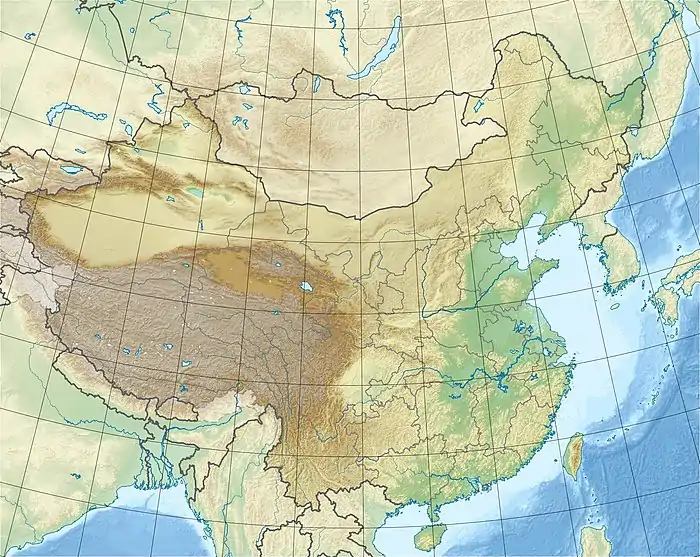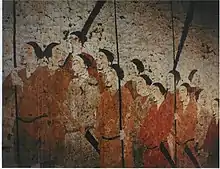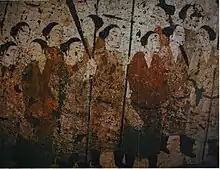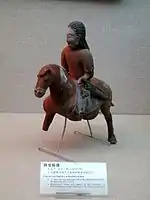Tomb of Xu Xianxiu
The Tomb of Xu Xianxiu (Chinese: 徐显秀墓; pinyin: Xú Xiǎnxiù mù) is located in Wangjiafeng village, Haofeng Township, Yingze District, Shanxi Province, China. It is the tomb of the Northern Qi Prince of Wu’an, and head of the imperial armies, Xu Xianxiu. The tomb, noted for its murals, was excavated during 2001–2003.
| Tomb of Xu Xianxiu | |
|---|---|
.jpg.webp) Panels from the tomb of Xu Xianxu, 571 CE | |
| Created | 571 CE (Northern Qi) |
 Wangjiafeng | |
Excavation and description of tomb
The tumulus-style tomb projects 5.2 meters above ground and is easily visible.[1] A fifteen-meter-long passageway begins south of the tomb at ground level and slopes down to the tomb entrance. The tomb chamber, which has a vaulted ceiling, is approximately 6.5 square meters and is made of grey stone.[2] On December 1, 2000, local villagers reported that the tomb had been looted. Working together, the staffs of the Shanxi Archaeological Department and the Taiyuan City Archaeological Depart entered the tomb and took photographs. Based on these photographs, the tomb was determined to be from the Northern Qi period.[3]
The official excavation began in 2001. The murals were in poor condition. The paintings were deteriorating and needed to be stabilized; this was done by using syringes and carefully injecting adhesive to bind the pigments to the tomb wall. Furthermore, there were many plant roots which had damaged the paintings and needed to be removed.[3] Although the tomb had been plundered at least five times, there were 550 burial items discovered within the tomb.[2]
Murals
Murals cover more than 300 square meters of the tomb.[4] To prepare the walls for the paintings, they were first coated with white plaster on which the artist outlined the design and filled it in with color.[1] The murals begin immediately upon entering the passageway. Going down, towards the coffin chamber, both walls alongside the path are covered with paintings. They begin with images that are now damaged but were probably mythical birds followed by an honor guard, then, closest to the chamber, are groups of men leading riderless horses. On either side of the entrance way, doormen stand solemnly holding whips. All four walls and ceiling of the tomb chamber are painted. The north wall, directly opposite the entrance, shows the deceased and his wife on canopied funerary couch,[5] presiding over a feast and surrounded by musicians playing Central Asian instruments.[6] On the western wall, the mural depicts a tacked-up riderless horse under a canopy, preceded by an honor guard. The focus of the eastern wall is an oxen-pulled chariot under a canopy. Like the western wall, an honor guard also precedes the chariot.[7] The south wall shows the honor guard. The clothes of the people in the murals are typical of the Xianbei people of that time.[8]
Looting and grave artifacts


Archaeologists discovered five looters' tunnels.[1] The numerous times that the tomb had been previously looted explain the fact that many of the burial goods were seriously damaged. The archaeologists found more than 200 pieces of porcelain and more than 320 ceramic figurines.[2] A West Asian or Mediterranean style gold ring mounted with a tourmaline was found among the remains of the coffin.[10] The semi-precious stone was carved with an enigmatic figure variously identified as being a Greek or a Sogdian deity.[11]
.jpg.webp) Gem-inlaid gold ring, tomb of Xu Xianxiu.[12]
Gem-inlaid gold ring, tomb of Xu Xianxiu.[12] Terracotta figurine, tomb of Xu Xianxu
Terracotta figurine, tomb of Xu Xianxu
Academic research
Although a scattering of bones was found in the tomb, no complete skeletons were found. This may be the result of Zoroastrian sky burial customs. The entrance to the tomb was originally carved with a blue dragon and a white tiger, but later a bird was painted over it. The tomb murals reflect the exchange and integration of the various cultures during the Northern and Southern Dynasties as well as being a vivid reflection of social life at that time.[10]
References
- Lingley, Kate (2014). "Silk Road Dress in a Chinese Tomb: Xu Xianxiu and Sixth-Century Cosmopolitanism" (PDF). The Silk Road. 12: 1–2. Retrieved 23 December 2020.
- Shanxisheng kaogu yanjiusuo and Taiyuan wenwu kaogu yanjiusuo 山西省考古研究所 太原市文物考古研究 所 (2003). "Taiyuan Bei Qi Xu Xianxiu mu fajue jianbao 太原北齐徐显秀墓发掘简报 (Brief Report on the Excavation of the Northern Qi Tomb of Xu Xianxiu at Taiyuan)". Wenwu 文物. 10: 16.
- "北齐徐显秀墓考古记". 三晋都市报. 2010-06-13. Archived from the original on 2011-11-11. Retrieved 2011-12-31.
- Chang, Willow Hai, Susan L. Beningson, J. May Lee Jung May Lee Barrett, Honolulu Museum of Art, and China Institute Gallery (2016). Art in a Time of Chaos: Masterworks from Six Dynasties China, 3rd–6th Centuries = Luan Shi Jue Xiang : Liu Chao Yi Shu, San Zhi Liu Shi Ji. New York: China Institute Gallery. p. 74. ISBN 9780692559901.
{{cite book}}: CS1 maint: multiple names: authors list (link) - Kyan, Winston (2010). "Family Space: Buddhist Materiality and Ancestral Fashioning in Mogao Cave 231". The Art Bulletin. 92 (1/2): 61–82. doi:10.1080/00043079.2010.10786140. S2CID 192182049.
- Dien, Albert (2007). Six Dynasties Civilization. Yale. p. 348. ISBN 9780300074048.
- Hung, Wu (2011). The Art of the Yellow Springs: Understanding Chinese Tombs. London: Reaktion Books. p. 210. ISBN 9781861896247.
- Lingley, Kate (2006). "The Multivalent Donor: Zhang Yuanfei at Shuiyu Si". Archives of Asian Art. 56: 27. doi:10.1484/aaa.2006.0002. JSTOR 20111335. Retrieved 24 December 2020.
- Lingley, Kate A. (2014). "Silk Road Dress in a Chinese Tomb: Xu Xianxiu and Sixth-century Cosmopolitanism" (PDF). The Silk Road. 12.
- Chang, Yimin (2006). "Bei Qi Xu Xianxiu mu fajue ji 北齐徐显秀墓发掘记 [Excavation report of the Northern Qi Tomb of Xu Xianxiu]". Wenwu Shijie 文物世界 (4): 16.
- Otani, Ikue. "Inlaid Rings and East-West Interaction in the Han-Tang Era". Academia.edu. Retrieved 9 February 2021.
- Otani, Ikue. "Inlaid Rings and East-West Interaction in the Han-Tang Era". Academia.edu. Retrieved 9 February 2021.


